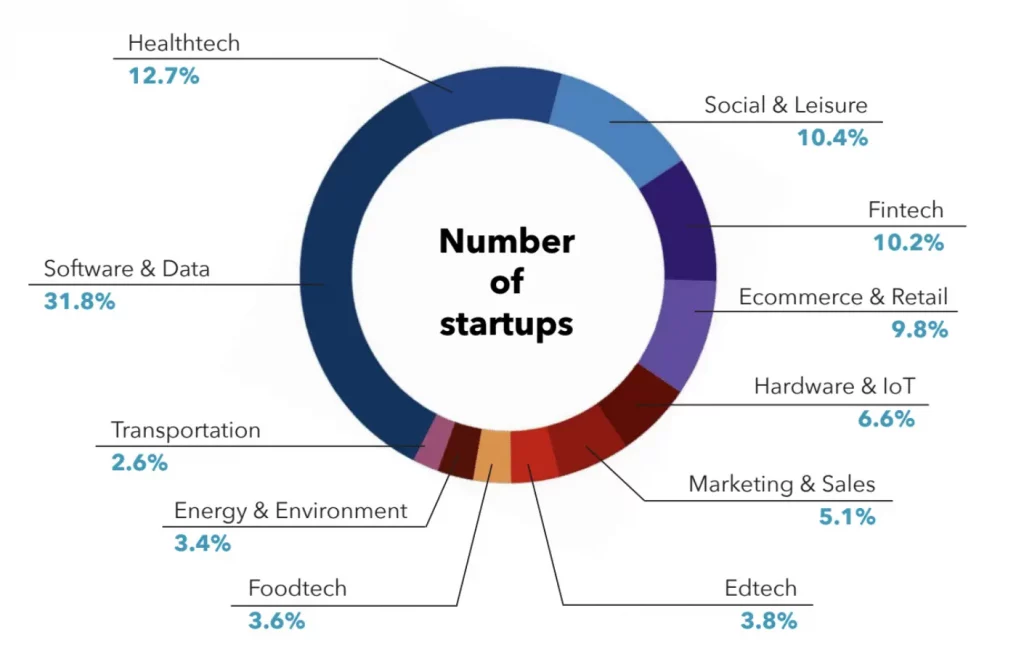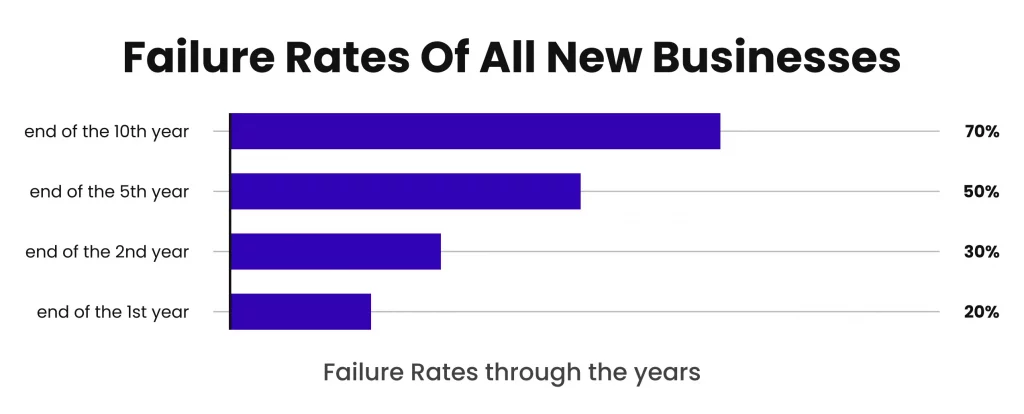A Secret to Successful Software Product Development for Startups – You Must Know
- Business
- September 20, 2022
In the age of digitalization, software product adoption has received a massive peak in the past few years. With easy access to digital products, many internet users ask for more specific software solutions to ease their work. To fulfill their demands, many software startups have come up with unique software solutions. Amongst them, many have succeeded, and some failed.
As per the latest data circulated by Crunchbase – to date in 2022, in the total number of 10,000 startups globally, the IT startup space has been recorded with 73.8% of the marketplace, in which:
- Software & data-based startups undoubtedly secure their 31.8% market share.
- HealthTech startups with a 12.7% market share
- FinTech startups with a 10.2% market share
- Hardware & IoT with a 6.6% market share
- Marketing & Sales with a 5.1% market share
- EdTech with a 3.8% market share
- FoodTech with a 3.6% market share

Launching a tech startup with a specific software product development with inspiration from silicon valley might seem a thrilling experience. But in reality, it is more like starting a challenging journey, where you’re competing with thousands of similar tech startups across the globe and trying to showcase your software product unique.
In this intense market competition, due to various factors, many startups meet failures. And around 80-90% of startups fail in the duration of the first ten years – says Failory Report.

Hence, you need a strong software product development plan to make your startup successful. Worry not! This guide is specifically designed to help you effectively plan your software product-based startup.
Before we move ahead with the best practice to develop a startup software product, let’s first know the reasons for startups’ failures.
Reasons Why Major Software Product-Based Startups Fail
If you see in the startup statistics, the major failure rates are in product-based startups as compared to service-based startups.
Therefore, knowing failure factors for product-based startups is a prerequisite to making your startup eminent:
1. Lack of Out-of-the-box Ideas (Innovation + Agility)
Launching a product-based startup is a big step. And using not so well-researched software product development ideas is the first drawback. It may lead your product-based startup to failure.
As per one study, 91% of startups fail due to a lack of innovation. Using random ideas and copying other successful startup product ideas also fall under the category of lack of out-of-the-box software development ideas.
Not only innovations but also a lack of software product diversity and agility to meet broad audiences’ expectations is a reason for a startup’s failure.
Solution:
- Excessive market research
- Fluid business development architecture
- Know the sustainability of software development
- Gather resources to make your software innovative
2. Software is Not So Well Optimized
All users want cutting-edge performance and rich features from your software. Poor performance of software might frustrate users and make them move to competitors’ products. Hence, this leads to less business revenue and maybe to failure in the worst-case scenario.
Hence, to make your software product efficient for your target audiences, you have to choose the emerging technology stack that promises better performance, continuous improvement, and a bright future.
3. Funding Problems
Every product-based startup needs better funding to run its commercial and marketing campaigns. Not having enough funds means compromising some features to implement, optimizing the solution for better user experience, chances and methods to spread your product awareness, and quick revenue generation.
Today’s internet users want to buy products and services that are popular and provided by well-known vendors. If they don’t know about the existence of your product, they won’t buy it, and they won’t get to experience it. Hence, one day, your product-based startup will meet failure.
Solutions:
- Create sound revenue models
- Decide financial margins on products and services from the start (fees + spending)
4. Product Market Fit
Major product-based startups fail due to their lack of market research:
- Don’t know the right market
- Less market opportunity
- Not having the right data to target the audience
- Product not creating the value for the audience
Many startups rush to development with the first software development idea they get without even exploring the future opportunities and business stability. Hence, their lack of research and product presentation in the marketplace leads startups to meet failure.
Solution:
- Know your marketplace
- Create a thorough understanding of your offering
- Deliver your product with full confidence and create a trustable relationship with your consumers
5. Lack of Customer-Centricity
Startups usually have too much to focus on their platter, including tons of client and investor meetings, talent hiring, gathering resources, product enhancements and maintenance, marketing and sales, etc. Hence, they sometimes lose focus on their target audience and do all things vaguely. Losing customer-centricity often leads startups to end their corporate journey.
Harvard business school review article says, “businesses keeping customers at the center of their operations, always find success in the market.”
Remember, for a product-based startup, getting valuable feedback and reviews from customers is the key to enhancing their product performance and thus expanding business.
Solution:
- Design your software product that eases your target audiences’ work.
- Take frequent feedback from users to enhance your product
- Always answer your software users’ queries
- Maintain a healthy, trustworthy relationship with your customers.
How to Develop A Successful Software Solution for A Startup?
Now, you know the crucial factors leading a product-based startup to loss. So, it’s time to get on the best practices and steps to develop your stellar software solution:
1. Research, Conceptualization, and Strategizing
As you have planned to become a product-based startup, you must have ideas and concepts to build your software product. All you have to do is:
Discovery: Conduct Extensive Market Research & Trend Analysis
We understand you have countless software product development ideas to launch your product-based startup. And those software ideas might seem unique to you and solve concerning problems.
In reality, there are many similar startups dominating the market. Hence, this market research will help you identify the right software development idea, create better market opportunities, target the right audiences, and strategize the whole product development and post-deployment plan.
Read also: How to Conduct Market Research for Mobile App Idea?
Define Unique Selling Propositions (USPs)
Now that you have your ideal software development idea, it’s time to make your product unique from your competitors. And that would be done by defining unique selling propositions satisfying target audiences and market demand.
USPs should also focus on solving certain industry problems and adding value for target customers to use your offered solution.
List Out Development Risks
This stage is for developers to figure out risks and challenges they might face soon for this product development. This risk analysis will help your project manager to curate the development team.
Further, this step will help you know ever-evolving customer needs. And thus, plan a series of versions with feature specifications that you’ll add to your software product. So, be futuristic with this stage!
2. Scoping & Software Development Idea Validation
This stage will help you scope the development in terms of narrowing down the concept for the target audience and validate it in terms of a mindmap to figure out the use cases and effectiveness of the idea.
Testing the Idea
The software product idea validation is done in three stages:
- Checking whether the idea is solving the target audience and industry concerning problems.
- An idea should meet your needs and expectations in all conditions, even in the market expansion conditions.
- You must ensure that your solution answers your users’ all queries the way you’ve comprehended.
- The features and functionalities you add and price charts you decide on should ensure that your target audiences are willing to pay and afford. This willingness to pay for your software services justifies the worthiness of your solution. It will eventually help your startup grow.
Scoping The Concept
For that, you’ll have to do intensive market and competitor analysis to scope your product. And SRS (Software Requirement Specification) document will be of great help.
This technical guide will include:
- Purpose
- Gain and Pain Ratio
- Innovative features and functionalities to implement
- Create value prepositions
- Software product development life cycle with a summary of procedures
- Considerations and specifications to implement
It is a typical technical guide prepared by the Business Analysis team and followed by all software development team members – Managers, Developers, Operations, and QAs. By this, the software development team can save much time and effort.
Next is the crucial stage of your software development where you bring your concept to life. Here, you’ll see the merger of software design and engineering.
3. IT Consultation
Now, you have your whole software development concept clear, so let’s move to the IT consultation stage. IT consultation will help you in many ways, like choosing:
- Right technology stack
- Budget finalizing
- Best-fit development model (Agile, Waterfall, etc.)
- IT engagement model (whether to outsource or hire dedicated IT staff), etc.
At MindInventory, we insist our clients to choose the Agile Methodology and flexible IT engagement model like staff augmentation solution. It will give assurance to clients of meeting their requirements in their software development under their budget.
4. Concept Design & Development
You’re now all set to go with bringing your concept to life. First, align the best and most creative UI/UX designers to create a concept design and prototype samples of your software. They will start with sketching and illustrating the feature and functionality requirements as mentioned in the SRS and market trend analysis documents.
Experienced UI/UX designers follow the best practice to create many samples of software UI/UX designs. Through this, you will get options to choose and test the best software UI/UX design that is easy to navigate and works the best for your target audience.
️ Remember, the finalized software UI/UX design is still in the basic stage. It will go through many amendments post-MVP launch based on its analytics.
With this, you will come up with the right design and prototype to move ahead with the MVP development.
Software Development
The MVP development is your budget-friendly and testing development with basic functionalities. This model development will give you ideas about additional features and functionalities to include in your software development.
Remember, the software development phase is the essential and longest phase. In this step, developers code the application with the selected technology stack and refer to the SRS documentation.
As a part of the software development best practice, developers will consecutively launch the alpha and beta versions of the software as ready-to-use software. These versions meet all the system requirements and are initially released for the selected users to test the software efficiency.
5. Pilot & Beta Test Your Software Product
Now, you have some concerning bug lists from the beta users. So, it’s time to perform QA testing for your product under certain conditions and resolve massive software bugs and exceptions.
Your initial software build would be known as an alpha build, which further be circulated for the Alpha & Pilot testing to the limited users (it could be a group of developers and non-tech users).
For developers, alpha testing includes white box and black box testing – known as user acceptance testing. This alpha testing will confront developers to points where their software is lagging, enhance its quality, and schedule it for the beta release.
In the beta testing, developers will put the product for the complete black box testing and make it live for the users who want to volunteer to use your product and provide bug reports from the front-end side. This beta testing phase may run long but will give developers and QA engineers the confidence to deploy the product into the public platform.
6. Software Product Launch
Finally, your startup product is ready to rock the global market, but the question is, “where will you host it?” For any startup, it is important to plan your software deployment wisely. Of course, you’ve built your software application to be compatible and responsive to all kinds of devices (smartphones, tablets, and PC).
In this age of cloud computing, you want to provide your users with a real-time user experience. Hence, you should host your mission-critical app in a secure public cloud platform – AWS, Azure, or GCP.
Cloud engineers at MindInventory team up with DevOps engineers to ensure rapid software delivery with cutting-edge performance and cybersecurity.
7. Post-Launch Strategy: Marketing + Profit Ratio
Launching cutting-edge, bug-free and crash-free software in the market might be a challenging task for startup developers, but an experienced army of developers at MindInventory knows how to put MVPs into the market and bring out impressive results.
Cost & Profit Analysis
Put business analysis into practice, calculate all expenses (planning + development + marketing) and define a fair price to sell your software. While doing the cost analysis, ensure that your software selling cost does not sound too much to your target audience, and less that creates a business loss.
Software Marketing Strategy
Now that your product innovation is rocking the market, it’s time to move to the product marketing strategy. And to make your product marketing successful, you need to involve several teams, content writers and copywriters, digital marketing managers, graphic designers, and product managers.
Moreover, use your previously done market study documents to know your market paradigm and create effective copies to impress your target audience.
Effective ways to market your startup software build:
- Compelling landing pages – SEO optimized
- Content strategy
- Ad-Campaigns
- Social media marketing
- Press Releases (Link Building)
- Video Marketing
- Email marketing
- Software product awareness video and short clips
8. Marketing Analytics & Feedback
Once you start your software marketing campaigns, use analytics tools to track your running ad campaigns. Also, you want to know your software users’ thoughts and experiences with your product.
Your product-based startup’s work doesn’t end with launching your software product. You also have to keep thinking about making improvements and further growth.
Offer your users rewarding prepositions to motivate them to give their valuable feedback. Their feedback will help you improve your software experience and grow your business. After all, satisfying customers’ ever-evolving demands ensures your startup has a bright future.
Now, the question arises, “how do you measure the popularity level of your software application?”
- Conduct your user behavior analysis to know how they engage with your software solution.
- Ask your users to tag your product link in their social media posts and stories to track down their willingness to recommend your product.
- When a new user buys your product, take their feedback to know how they knew about it and the reasons they want to use it.
- Ask them frequently (once a month), “how much do they recommend your software solution in their close circle?”
- Check for client lifetime value and churn rate for users who unsubscribed from your services.
- Lastly, ensure your total investment in the software improvisation and maintenance Vs. total sales to figure out total revenue.
This data will help you plan your further business improvement and expansion strategies.
9. Frequent Maintenance & Scaling Up
It is the final and continuous stage of your product-based startup, which ensures the scaling up of your business. Gather all feedback, digital marketing analytics, and user behavioral results to improve your software product.
Software enhancement might take a long cycle, but software maintenance should be done in monthly intervals to ensure its cutting-edge performance. Product maintenance, proactively solving customers’ queries, and helping them improve their user experience will indeed help you amplify your market appearance.
You should always maintain enough aligned IT resources to provide quick help-desk support and boost maintenance procedures. As your startup is in its initial phase, you can create your in-house software maintenance and customer support teams. And later on, you may think of outsourcing it to another IT company as you scale up.
When you have launched your startup, you must have made your roadmap to follow in the next decade along with the startup expansion plan. If you haven’t created it yet, consider it’s time to do it for smooth business scaling up internationally.
How Can MindInventory Help You with Your Startup Product Development?
Indeed, the initial startup journey is not a buttery way but is full of failure obstacles. A well-approached startup product development idea and development plan with a loyal and experienced team of developers is the only best practice to thrive your product-based startup to success.
Of course, you’ll need the guidance of IT experts working in this industry for over ten years to plan your software product development efficiently. And that’s why we at MindInventory exist with our client-centric principles. Approach us today with your software development queries and schedule a quick meeting with our expert IT consultants.
FAQs On Startup Product Development
Software product development is a crucial process, which is mainly divided into stages, including ideation and validation, strategizing for development and post-deployment, execution, and improvement for better scaling up opportunities.
If you see, most successful startups who started as service-based startups ended up being product-based startups. It shows that launching your product-based startup is itself a beneficial one. Because you have your business vision clear and your own stream of audiences, you can focus more on knowing your users’ demands and be client-centric easily, you have fewer diversions to tackle, and so on.
MindInventory is an evolving IT company providing expert IT consultation services to startups for successfully developing and launching their software solutions with proper business analysis. As you see, to date, we have helped 1000+ international startups, SMBs, and enterprises to successfully launch their digital services with our stellar software development solutions. So, what are you waiting for? Hit the contact us button today and get your quote for software product development!













